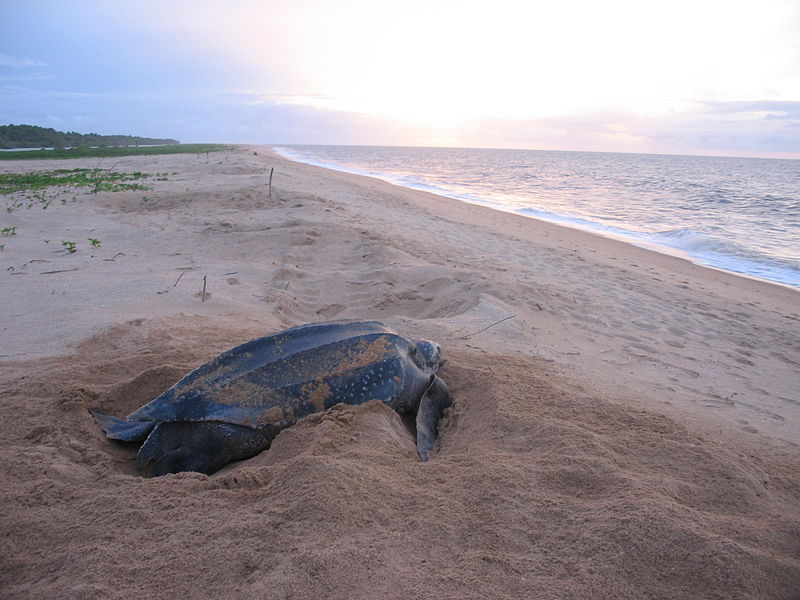For Immediate Release
March 11, 2004
CONTACT: Todd Steiner (415) 488 0370 x103
Brendan Cummings (909) 659 6053 ext 301
Environmentalists Applaud Ban On California Longline Fishing To Protect Endangered Sea Turtles
Final Rules Issued by US Fisheries Following Lawsuit by Environmentalists
March 11, 2004—Today, the US Fisheries Service issued new rules banning California longline fishing from targeting swordfish from a huge swath of the Pacific Ocean. The final rule comes on the heels of an August 2003 decision by the federal Ninth Circuit Court concurring with environmentalists that the Fisheries Service had failed to conduct the proper environmental review before issuing permits to the fishery. The banning of longlining in this area will protect endangered sea turtles in the Pacific and close a significant loophole that was undermining other conservation efforts.
Specifically, the new rules, designed to protect endangered leatherback and green sea turtles, prohibit vessels that land their catch in California from conducting shallow swordfish longline sets on the high seas in the Pacific Ocean east of 150º W. longitude to protect endangered leatherback and loggerhead sea turtles. This type of longlining is already banned for all US longline vessels landing in Hawaii and all longlining is also banned in California State waters. Shallow set longlining fishing will be banned west of 150º W. longitude in approximately one month, when the draft Pacific Fishery Management Plan is approved.
“This is another important victory for the sea turtles,” said Todd Steiner, Director of Turtle Island Restoration Network. “If we are to save the critically endangered Pacific leatherback, the largest reptile on earth, we need to severely curb longline fishing.”
“These longliners have been fishing with the same gear in the same areas and kill the same endangered sea turtles that Hawaii longliners used to until they were shut down a few years ago. The only difference is that these fishers land their catch in California, instead of Hawaii and thus skirt the law to protect these endangered species,” said Brendan Cummings, an attorney for the Center for Biological Diversity.
Prior to the ruling in Hawaii, many of the California vessels maintained dual permits to land in Hawaiian and Californian ports, but now they simply land in California. California longliners set approximately one million hooks per year.
Background
In 2002, the Center for Biological Diversity and Turtle Island filed suit to close the California loophole, following a 2001 federal ruling which closed Hawaii’s swordfish fishery and partially restricted the tuna longline fishery to protect critically endangered sea turtles. In March 2002, NMFS declared that the Hawai`i-based longline fishery was placing leatherback, loggerhead, and green turtles at risk of extinction and completely banned swordfish longlining out of Hawai`i.
Longline fishing, an industrial technology that can set thousands of baited hooks in a single set, and that internationally sets 2 billion hooks per year (or 5 million hooks/day) has been implicated in a study published in Nature, as the major cause of the decline of giant fishes, such as swordfish, tuna and sharks. Previous scientific studies have also indicated that this fishing method is driving Pacific leatherbacks turtles to extinction, as well as being responsible for the deaths of hundreds of thousands of seabirds each year.
Several years ago, scientists began reporting that populations of Pacific leatherback sea turtles were crashing. In 2002 scientists from around the world held a conference in Monterey to discuss the crisis. Dr. Jim Spotila of Drexel University and Chair of the International Union for the Conservation of Nature (IUCN) Leatherback Specialist Group stated, “Despite 15 years of protection of virtually every female and nest at Las Baulas National Park in Costa Rica, the annual nesting population has dropped from 1,267 14 years ago to 65 in 2003, the lowest ever recorded for this beach.”
“Without global efforts to reduce fishing-related mortality, the Pacific leatherback is a goner,” added Steiner. “The Pacific leatherback is just the canary in the coalmine. Unless we end industrial longlining as it is practiced today, sea turtles, seabirds, sharks and many important food fish will be wiped out too.”
Nesting studies from around the world showed that population numbers continue to decline. More than 400 scientists and 100 non-governmental organizations have called on the United Nations to place a moratorium of longlining in the Pacific to protect sea turtles, sharks, seabirds and other species.
“We have to question why we are allowing thousands of endangered marine species to be killed to catch swordfish- a species so laden in poisonous mercury that the Food and Drug Administration warns pregnant women and children not to consume it at all,” commented Steiner.




